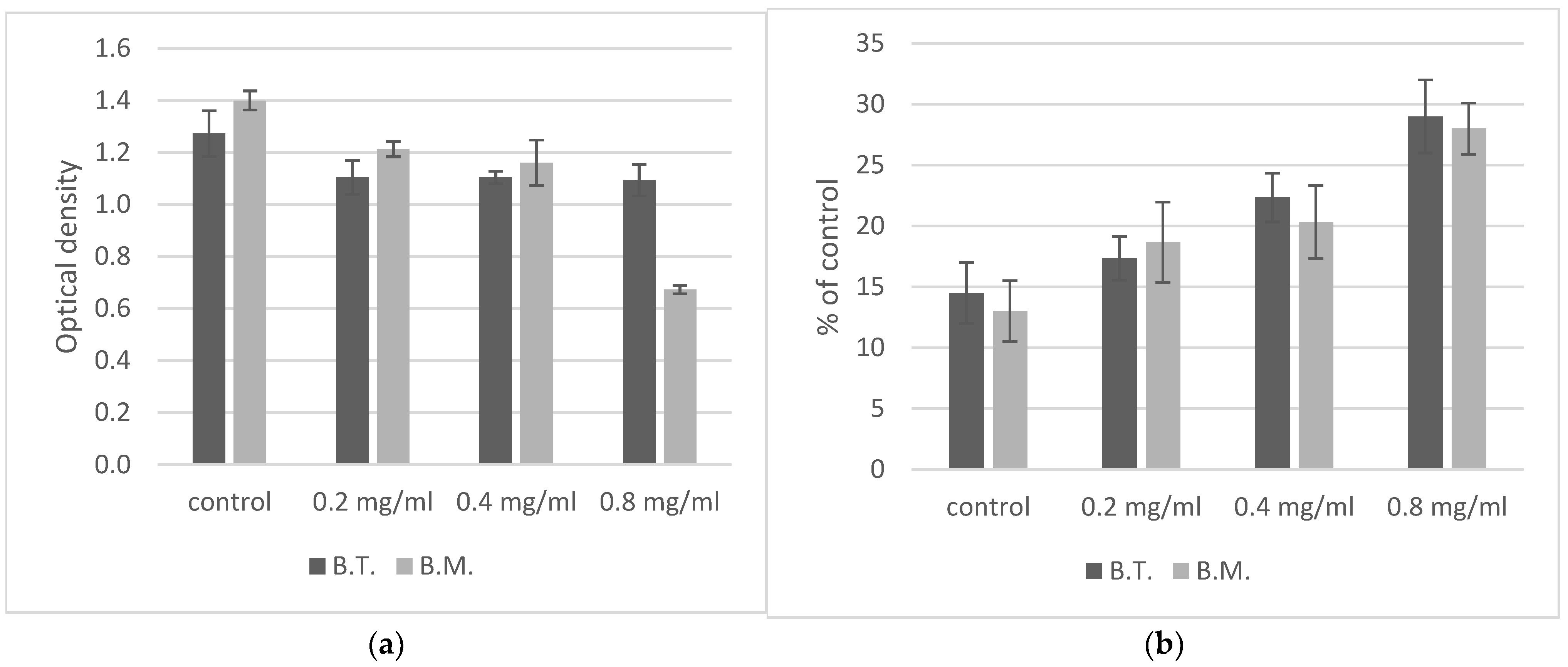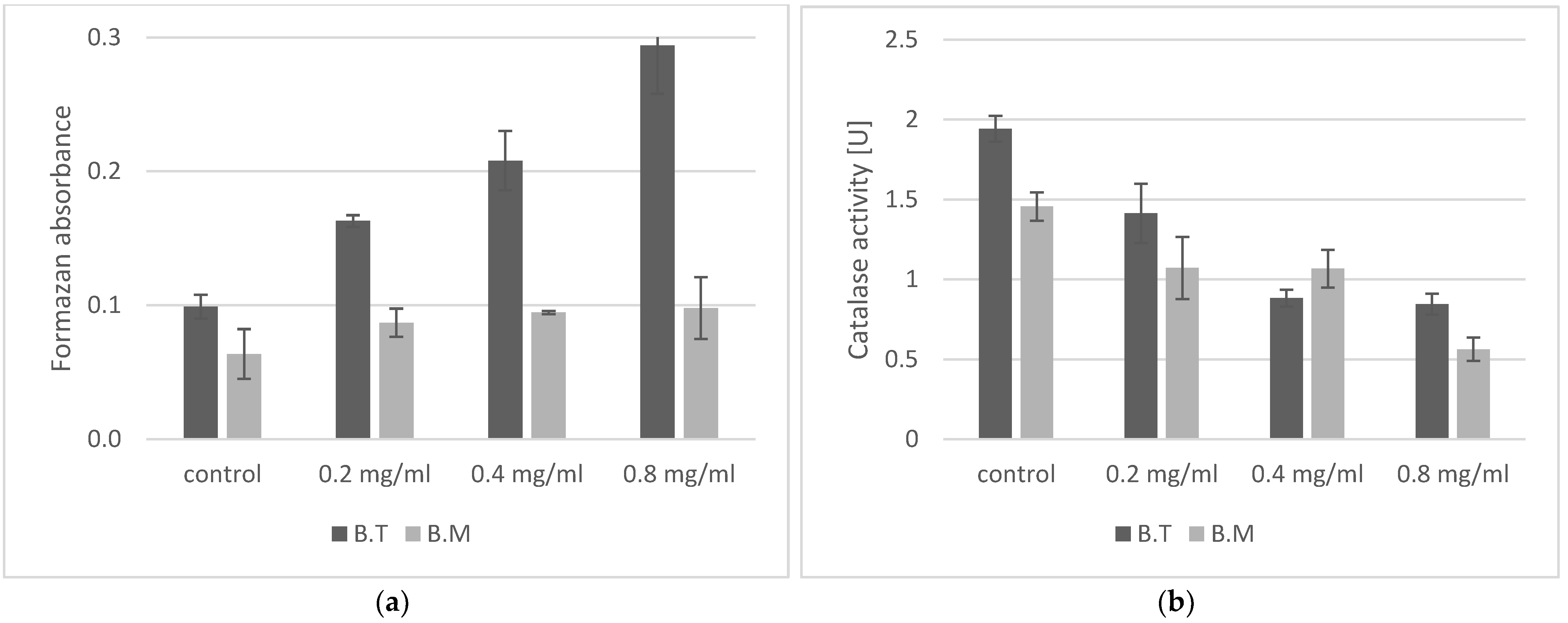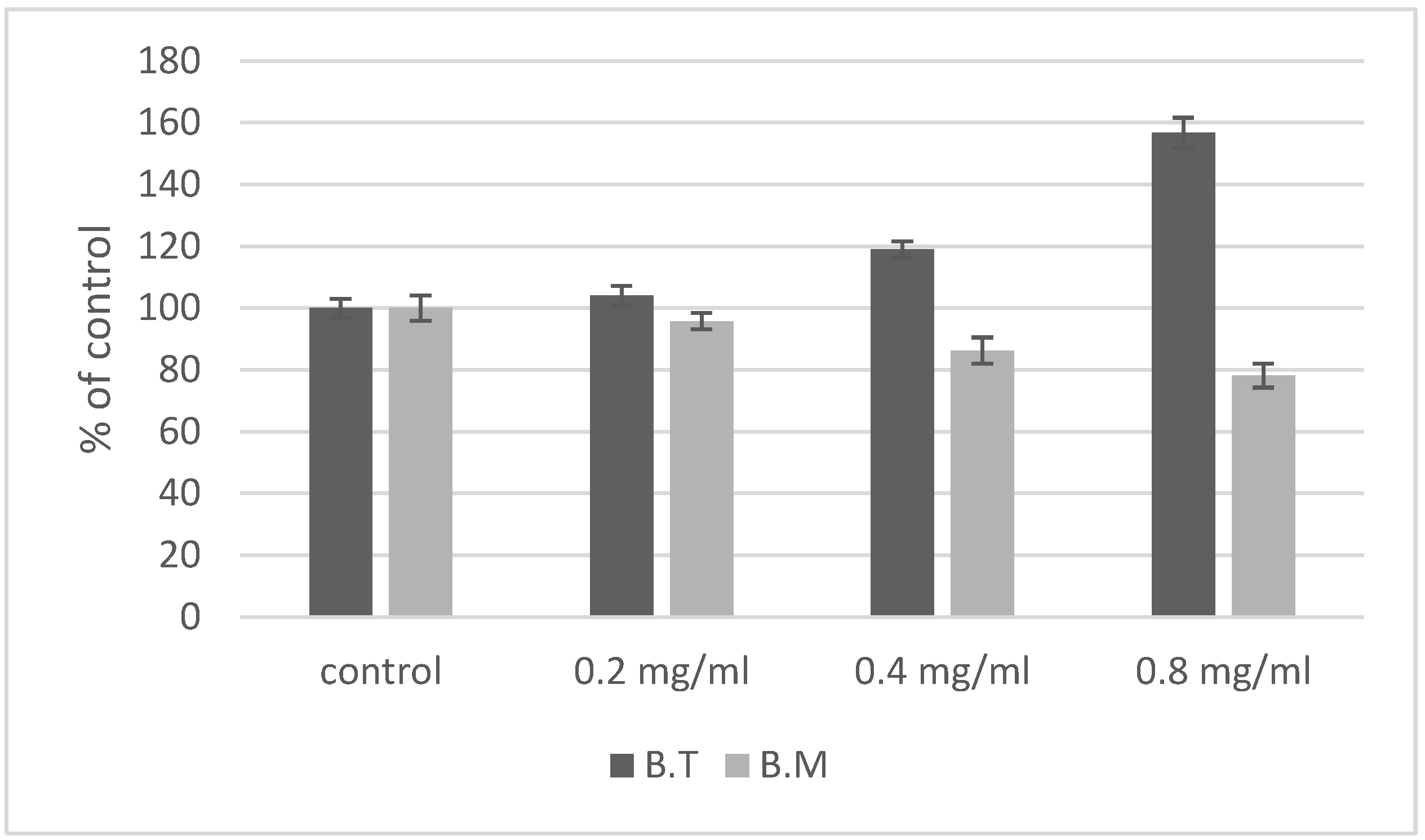Model Study for Interaction of Sublethal Doses of Zinc Oxide Nanoparticles with Environmentally Beneficial Bacteria Bacillus thuringiensis and Bacillus megaterium
Abstract
:1. Introduction
2. Results
2.1. Growth Parameters of Bacillus spp. after Incubation with ZnO NPs
2.2. Oxidative Stress in Bacillus Cells in the Presence of ZnO NPs
2.3. Effect of ZnO NPs on Biofilm Formation
2.4. IAA Production
2.5. Decolorization of the Azo Dye Evans Blue
3. Discussion
4. Materials and Methods
4.1. Zinc Oxide Nanoparticles
4.2. Bacteria and Determination of Growth Parameters
4.3. Determination of Superoxide Radicals in Stress Conditions Induced by ZnO NPs
4.4. Determination of Catalase Activity
4.5. Crystal Violet Assay to Determine the Effect of ZnO NPs on Biofilm Formation
4.6. IAA Production in Conditions of Incubation with ZnO NPs
4.7. Degradation of Evans Blue
4.8. Statistics
5. Conclusions
Author Contributions
Funding
Institutional Review Board Statement
Informed Consent Statement
Data Availability Statement
Conflicts of Interest
References
- Keller, A.A.; McFerran, S.; Lazareva, A.; Suh, S. Global life cycle releases of engineered nanomaterials. J. Nanoparticle Res. 2013, 15, 1692. [Google Scholar] [CrossRef]
- Kim, I.; Viswanathan, K.; Kasi, G.; Thanakkasaranee, S.; Sadeghi, K.; Seo, J. ZnO Nanostructures in active antibacterial food packaging: Preparation methods, antimicrobial mechanisms, safety issues, future prospects, and challenges. Food Rev. Int. 2020, 38, 537–565. [Google Scholar] [CrossRef] [Green Version]
- Schneider, S.L.; Lim, H.W. A review of inorganic UV filters zinc oxide and titanium dioxide. Photodermatol. Photoimmunol. Photomed 2018, 35, 442–446. [Google Scholar] [CrossRef] [PubMed] [Green Version]
- Sruthi, S.; Ashtami, J.; Mohanan, P.V. Biomedical application and hidden toxicity of zinc oxide nanoparticles. Mater. Today Chem. 2018, 10, 175–186. [Google Scholar] [CrossRef]
- Sirelkhatim, A.; Mahmud, S.; Seeni, A.; Kaus, N.H.M.; Ann, L.C.; Bakhori, S.K.M.; Hasan, H.; Mohamad, D. Review on zinc oxide nanoparticles: Antibacterial activity and toxicity mechanism. Nanomicro. Lett. 2015, 7, 219–242. [Google Scholar] [CrossRef] [Green Version]
- Beyene, Z.; Ghosh, R. Effect of zinc oxide addition on antimicrobial and antibiofilm activity of hydroxyapatite: A potential nanocomposite for biomedical applications. Mater. Today Commun. 2019, 21, 100612. [Google Scholar] [CrossRef]
- Leareng, S.K.; Ubomba-Jaswa, E.; Musee, N. Zinc oxide and iron oxide engineered nanoparticles toxicity on Bacillus subtilis in river water systems. Environ. Sci. Nano. 2019, 7, 172–185. [Google Scholar] [CrossRef]
- Bhuyan, T.; Mishra, K.; Khanuja, M.; Prasad, R.; Varma, A. Biosynthesis of zinc oxide nanoparticles from Azadirachta indica for antibacterial and photocatalytic applications. Mat Sci. Semicon. Proc. 2015, 32, 55–61. [Google Scholar] [CrossRef]
- Rajput, V.D.; Minkina, T.; Sushkova, S.; Tsitsuashvili, V.; Mandzhieva, S.; Gorovtsov, A.; Gromakova, N. Effect of nanoparticles on crops and soil microbial communities. J. Soil. Sediments 2018, 18, 2179–2187. [Google Scholar] [CrossRef]
- Eymard-Vernain, E.; Luche, S.; Rabilloud, T.; Lelong, C. Impact of nanoparticles on the Bacillus subtilis (3610) competence. Sci. Rep. 2018, 8, 2978. [Google Scholar] [CrossRef]
- Su, Y.; Liu, C.; Fang, H.; Zhang, D. Bacillus subtilis: A universal cell factory for industry, agriculture, biomaterials and medicine. Microb. Cell Factories 2020, 19, 173. [Google Scholar] [CrossRef]
- Prakash, J.; Arora, N.K. Phosphate-solubilizing Bacillus sp. Enhances growth, phosphorus uptake and oil yield of Mentha arvensis. Biotech 2019, 9, 126. [Google Scholar] [CrossRef]
- Wagi, S.; Ahmed, A. Bacillus Spp.: Potent microfactories of bacterial IAA. Peer J. 2019, 7, e7258. [Google Scholar] [CrossRef] [Green Version]
- Saeid, A.; Prochownik, E.; Dobrowolska-Iwanek, J. Phosphorus solubilization by Bacillus species. Molecules 2018, 23, 2897. [Google Scholar] [CrossRef] [Green Version]
- Mahapatra, S.; Yadav, R.; Ramakrishna, W. Bacillus subtilis impact on plant growth, soil health and environment: Dr. Jekyll and Mr. Hyde. J. Appl. Microbiol. 2022, 132, 3543–3562. [Google Scholar] [CrossRef]
- Wilson, M.K.; Abergel, R.J.; Raymond, K.N.; Arceneaux, J.E.L.; Byers, B.R. Siderophores of Bacillus anthracis, Bacillus cereus, and Bacillus thuringiensis. Biochem. Biophys. Res. Commun. 2006, 348, 320–325. [Google Scholar] [CrossRef]
- Dawkar, V.V.; Jadhav, U.U.; Jadhav, S.U.; Govindwar, S.P. Biodegradation of disperse textile dye Brown 3REL by newly isolated Bacillus sp. VUS. J. Appl. Microbiol. 2008, 105, 14–24. [Google Scholar] [CrossRef]
- Pishchik, V.N.; Filippova, P.S.; Mirskaya, G.V.; Khomyakov, Y.V.; Vertebny, V.E.; Dubovitskaya, V.I.; Chebotar, V.K. Epiphytic PGPB Bacillus megaterium AFI1 and Paenibacillus nicotianae AFI2 improve wheat growth and antioxidant status under Ni stress. Plants 2021, 10, 2334. [Google Scholar] [CrossRef]
- Tozlu, E.; Tekiner, N.; Kotan, R.; Örtücü, S. Investigation on the biological control of Alternaria alternata. Indian J. Agric. Sci. 2018, 88, 1241–1248. [Google Scholar]
- Xiao, Y.; Wu, K. Recent progress on the interaction between insects and Bacillus thuringiensis crops. Philos. Trans. R. Soc. Lond. B Biol. Sci. 2019, 374, 20180316. [Google Scholar] [CrossRef] [Green Version]
- Wang, Z.W.; Liang, J.S.; Liang, Y. Decolorization of reactive Black 5 by a newly isolated bacterium Bacillus sp. YZU1. Int. Biodeterior. Biodegrad. 2013, 76, 41–48. [Google Scholar] [CrossRef]
- Chavan, S.; Nadanathangam, V. Effects of nanoparticles on plant growth-promoting bacteria in Indian agricultural soil. Agronomy 2019, 9, 140. [Google Scholar] [CrossRef] [Green Version]
- Hussey, M.A.; Zayaitz, A. Endospore stain protocol. Am. Soc. Microbiol. 2007, 8, 1–11. [Google Scholar]
- Paździoch-Czochra, M. Relationship of demethylation processes to veratric acid concentration and cell density in cultures of Rhodococcus erythropolis. Cell Biol. Int. 2003, 27, 325–336. [Google Scholar] [CrossRef]
- Skwaryło-Bednarz, B.; Krzepiłko, A.; Brodowska, M.; Brodowski, R.; Ziemińska-Smyk, M.; Onuch, J.; Gradziuk, B. The impact of copper on catalase activity and antioxidant properties of soil under amaranth cultivation. J. Elem. 2018, 23, 825–836. [Google Scholar] [CrossRef]
- Ma, W.; Peng, D.; Walker, S.L.; Cao, B.; Gao, C.-H.; Huang, Q.; Cai, P. Bacillus subtilis biofilm development in the presence of soil clay minerals and iron oxides. NPJ Biofilms Microbiomes 2017, 4, 4. [Google Scholar] [CrossRef] [PubMed]
- Naher, J.; Chowdhury, S.A.; Mamun, A.A.; Mahmud, N.; Shumi, W.; Khan, R.A. A Comparative study on the biofilm formation of Enterobacter agglomerans and Serretia rubideae in different environmental parameter under single culture condition. Open J. Med. Microbiol. 2014, 4, 70–76. [Google Scholar] [CrossRef] [Green Version]
- Ahmed, A.; Hasnain, S. Auxin-Producing Bacillus Sp.: Auxin quantification and effect on the growth of Solanum tuberosum. Pure Appl. Chem. 2010, 82, 313–319. [Google Scholar] [CrossRef]
- Xia, J.; Wang, Q.; Luo, Q.; Chen, Y.; Liao, X.-R.; Guan, Z.B. Secretory expression and optimization of Bacillus pumilus CotA-laccase mutant GWLF in Pichia pastoris and its mechanism on Evans blue degradation. Process Biochem. 2019, 78, 33–41. [Google Scholar] [CrossRef]
- Azam, A.; Ahmed, A.; Oves, M.; Khan, M.; Habib, S.; Memic, A. Antimicrobial activity of metal oxide nanoparticles against gram-positive and gram-negative bacteria: A comparative study. Int. J. Nanomed. 2012, 7, 6003–6009. [Google Scholar] [CrossRef] [Green Version]
- Arakha, M.; Saleem, M.; Mallick, B.C.; Jha, S. The effects of interfacial potential on antimicrobial propensity of ZnO nanoparticle. Sci. Rep. 2015, 5, 9578. [Google Scholar] [CrossRef] [Green Version]
- Akhtar, N.; Khan, S.; Rehman, S.U.; Rehman, Z.U.; Mashwani, Z.U.R.; Rha, E.S.; Jamil, M. Zinc oxide nanoparticles enhance the tolerance and remediation potential of Bacillus spp. against heavy metal stress. Adsorp. Sci. Technol. 2021, 2021, 1–16. [Google Scholar] [CrossRef]
- Ahmed, B.; Ameen, F.; Rizvi, A.; Ali, K.; Sonbol, H.; Zaidi, A.; Khan, M.S.; Musarrat, J. Destruction of cell topography, morphology, membrane, inhibition of respiration, biofilm formation, and bioactive molecule production by nanoparticles of Ag, ZnO, CuO, TiO2, and Al2O3 toward beneficial soil bacteria. ACS Omega 2020, 5, 7861–7876. [Google Scholar] [CrossRef] [Green Version]
- Talebian, N.; Amininezhad, S.M.; Doudi, M. Controllable synthesis of ZnO nanoparticles and their morphology-dependent antibacterial and optical properties. J. Photochem. Photobiol. B Biol. 2013, 120, 66–73. [Google Scholar] [CrossRef]
- Boddupalli, A.; Tiwari, R.; Sharma, A.; Singh, S.; Prasanna, R.; Nain, L. Elucidating the interactions and phytotoxicity of zinc oxide nanoparticles with agriculturally beneficial bacteria and selected crop plants. Folia Microbiol. 2017, 62, 253–262. [Google Scholar] [CrossRef]
- Canaparo, R.; Foglietta, F.; Limongi, T.; Serpe, L. Biomedical applications of reactive oxygen species generation by metal nanoparticles. Materials 2020, 14, 53. [Google Scholar] [CrossRef]
- Ahmed, B.; Solanki, B.; Zaidi, A.; Khan, M.S.; Musarrat, J. Bacterial toxicity of biomimetic green zinc oxide nanoantibiotic: Insights into ZnO NPs uptake and nanocolloid–bacteria interface. Toxicol. Res. 2019, 8, 246–261. [Google Scholar] [CrossRef] [Green Version]
- Van der Steen, J.B.; Hellingwerf, K.J. Activation of the general stress response of Bacillus subtilis by visible light. Photochem. Photobiol. 2015, 91, 1032–1045. [Google Scholar] [CrossRef]
- Den Besten, H.M.W.; Effraimidou, S.; Abee, T. Catalase activity as a biomarker for mild-stress-induced robustness in Bacillus weihenstephanensis. Appl. Environ. Microbiol. 2013, 79, 57–62. [Google Scholar] [CrossRef] [Green Version]
- Awasthi, A.; Sharma, P.; Jangir, L.; Kamakshi; Awasthi, G.; Awasthi, K.K.; Awasthi, K. Dose dependent enhanced antibacterial effects and reduced biofilm activity against Bacillus subtilis in presence of ZnO nanoparticles. Mater. Sci. Eng. C 2020, 113, 111021. [Google Scholar] [CrossRef]
- Bonnet, M.; Massard, C.; Veisseire, P.; Camares, O.; Awitor, K.O. Environmental toxicity and antimicrobial efficiency of titanium dioxide nanoparticles in suspension. J. Biomater. Nanobiotechnol. 2015, 6, 213–224. [Google Scholar] [CrossRef] [Green Version]
- Habash, M.B.; Goodyear, M.C.; Park, A.J.; Surette, M.D.; Vis, E.C.; Harris, R.J.; Khursigara, C.M. Potentiation of Tobramycin by silver nanoparticles against Pseudomonas aeruginosa biofilms. Antimicrob. Agents Chemother. 2017, 61, 415–417. [Google Scholar] [CrossRef]
- Qayyum, S.; Oves, M.; Khan, A.U. Obliteration of bacterial growth and biofilm through ROS generation by facilely synthesized green silver nanoparticles. PLoS ONE 2017, 12, e0181363. [Google Scholar] [CrossRef] [Green Version]
- LewisOscar, F.; MubarakAli, D.; Nithya, C.; Priyanka, R.; Gopinath, V.; Alharbi, N.S.; Thajuddin, N. One pot synthesis and anti-biofilm potential of copper nanoparticles (CuNPs) against clinical strains of Pseudomonas aeruginosa. Biofouling 2015, 31, 379–391. [Google Scholar] [CrossRef]
- Ghasemian, E.; Naghoni, A.; Rahvar, H.; Kialha, M.; Tabaraie, B. Evaluating the effect of copper nanoparticles in inhibiting Pseudomonas aeruginosa and Listeria monocytogenes biofilm formation. Jundishapur J. Microbiol. 2015, 8, e17430. [Google Scholar] [CrossRef] [Green Version]
- Pati, R.; Mehta, R.K.; Mohanty, S.; Padhi, A.; Sengupta, M.; Vaseeharan, B.; Goswami, C.; Sonawane, A. Topical application of zinc oxide nanoparticles reduces bacterial skin infection in mice and exhibits antibacterial activity by inducing oxidative stress response and cell membrane disintegration in macrophages. Nanomedicine 2014, 10, 1195–1208. [Google Scholar] [CrossRef]
- Haris, Z.; Ahmad, I. Impact of metal oxide nanoparticles on beneficial soil microorganisms and their secondary metabolites. Int. J. Life Sci. Sci. Ses. 2017, 3, 1020–1030. [Google Scholar] [CrossRef]
- Dimkpa, C.O.; Zeng, J.; McLean, J.E.; Britt, D.W.; Zhan, J.; Anderson, A.J. Production of indole-3-acetic acid via the indole-3-acetamide pathway in the plant-beneficial bacterium Pseudomonas chlororaphis O6 is inhibited by ZnO nanoparticles but enhanced by CuO nanoparticles. Appl. Environ. Microbiol. 2012, 78, 1404–1410. [Google Scholar] [CrossRef] [PubMed] [Green Version]
- Zabłocka-Godlewska, E.; Przystaś, W.; Grabińska-Sota, E. Decolourisation of different dyes by two Pseudomonas strains under various growth conditions. Water Air Soil Pollut. 2014, 225, 1846. [Google Scholar] [CrossRef] [PubMed] [Green Version]
- Deng, D.; Guo, J.; Zeng, G.; Sun, G. Decolorization of anthraquinone, triphenylmethane and azo dyes by a new isolated Bacillus cereus strain DC11. Int. Biodeterior. Biodegrad. 2008, 62, 263–269. [Google Scholar] [CrossRef]
- Tony, B.D.; Goyal, D.; Khanna, S. Decolorization of textile azo dyes by aerobic bacterial consortium. Int. Biodeterior. Biodegrad. 2009, 63, 462–469. [Google Scholar] [CrossRef]
- Wang, T.; Liu, M.-Q.; Li, H.-X. Inoculation of phosphate-solubilizing bacteria Bacillus thuringiensis B1 increases available phosphorus and growth of peanut in acidic soil. Acta Agric. Scand. B Soil Plant Sci. 2014, 64, 252–259. [Google Scholar] [CrossRef]
- Sharma, S.C.D.; Sun, Q.; Li, J.; Wang, Y.; Suanon, F.; Yang, J.; Yu, C.-P. Decolorization of azo dye methyl red by suspended and co-immobilized bacterial cells with mediators anthraquinone-2,6-disulfonate and Fe3O4 nanoparticles. Int. Biodeterior. Biodegrad. 2016, 112, 88–97. [Google Scholar] [CrossRef] [Green Version]
- Bekhit, F.; Farag, S.; Attia, A.M. Decolorization and degradation of the azo dye by bacterial cells coated with magnetic iron oxide nanoparticles. Environ. Nanotechnol. Monit. Manag. 2020, 14, 100376. [Google Scholar] [CrossRef]
- Divya, B.; Karthikeyan, C.; Rajasimman, M. Chemical synthesis of zinc oxide nanoparticles and its application of dye decolourization. Int. J. Nanosci. Nanotechnol. 2018, 14, 267–275. [Google Scholar]





| Growth/ Metabolic Parameters | Pearson Correlation Coefficients | ZnO NP Dose Effect | Influence of Strain Type on ZnO NP Dose Response | |||
|---|---|---|---|---|---|---|
| B.T | B.M | p-Value | Test F | p-Value | Test F | |
| Planktonic growth | −0.5929 | −0.9488 | 3.9 × 10−28 | 2.748 | 0.118 | 3.991 |
| Spore formation | 0.9805 | 0.9696 | 7.0 × 10−12 | 3.239 | 0.142 | 4.494 |
| NBT reduction | 0.8341 | 0.5453 | 0.001 | 3.239 | 2.1 × 10−5 | 4.494 |
| Catalase activity | −0.8816 | −0.9597 | 0.731 | 4.757 | 0.069 | 5.153 |
| Biofilm formation | −0.3723 | 0.7478 | 8.8 × 10−37 | 2.758 | 6.7 × 10−7 | 3.150 |
| IAA production | 0.6004 | −0.9143 | 1.8 × 10−5 | 2.769 | 3.6 × 10−21 | 4.013 |
| Evans blue decolorization | −0.7728 | −0.8254 | 1.8 × 10−12 | 3238 | 3.9 × 10−3 | 4.499 |
Publisher’s Note: MDPI stays neutral with regard to jurisdictional claims in published maps and institutional affiliations. |
© 2022 by the authors. Licensee MDPI, Basel, Switzerland. This article is an open access article distributed under the terms and conditions of the Creative Commons Attribution (CC BY) license (https://creativecommons.org/licenses/by/4.0/).
Share and Cite
Matyszczuk, K.; Krzepiłko, A. Model Study for Interaction of Sublethal Doses of Zinc Oxide Nanoparticles with Environmentally Beneficial Bacteria Bacillus thuringiensis and Bacillus megaterium. Int. J. Mol. Sci. 2022, 23, 11820. https://doi.org/10.3390/ijms231911820
Matyszczuk K, Krzepiłko A. Model Study for Interaction of Sublethal Doses of Zinc Oxide Nanoparticles with Environmentally Beneficial Bacteria Bacillus thuringiensis and Bacillus megaterium. International Journal of Molecular Sciences. 2022; 23(19):11820. https://doi.org/10.3390/ijms231911820
Chicago/Turabian StyleMatyszczuk, Katarzyna, and Anna Krzepiłko. 2022. "Model Study for Interaction of Sublethal Doses of Zinc Oxide Nanoparticles with Environmentally Beneficial Bacteria Bacillus thuringiensis and Bacillus megaterium" International Journal of Molecular Sciences 23, no. 19: 11820. https://doi.org/10.3390/ijms231911820
APA StyleMatyszczuk, K., & Krzepiłko, A. (2022). Model Study for Interaction of Sublethal Doses of Zinc Oxide Nanoparticles with Environmentally Beneficial Bacteria Bacillus thuringiensis and Bacillus megaterium. International Journal of Molecular Sciences, 23(19), 11820. https://doi.org/10.3390/ijms231911820







